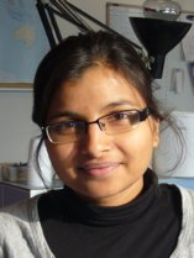Surface chemistry of tailored ceria nanoparticles: Interaction with CO and H2O
Promotion date: April 3.
Promotor: Prof.dr.ir. Leon Lefferts
Assistant Promotor: Dr. Barbara Mojet
| Steam reforming of bio-oil combined with the gasification of coke deposits in the presence of water, is a conceptually promising alternative to generate hydrogen gas. H2O can be activated in the gasification stage to form hydroxyl groups (OH) on oxide-supported (like ceria) metal catalysts, which increases both the H2 yield and the catalyst’s lifetime. The reactivity for the water dissociation as well as the reactivity of resulting hydroxyl groups, can be further improved by altering the shape and size of ceria support. Ceria nanoshapes exhibit excellent redox properties and high specific activity/selectivity in comparison to the bulk ceria particles. However, the knowledge related to the surface species actually responsible for enhanced catalytic activity of ceria nanocatalysts so far remains lacking. This thesis work highlights the fundamental aspects of ceria nanoshapes, with emphasis on the effects of surface planes on overall catalytic performance. Definitive information on the nature of the exposed surfaces in these CeO2 nanoshapes is provided using aberration-corrected transmission electron microscopy (AC-TEM) and high-angle annular dark field imaging (HAADF). Additionally, H2-reduced ceria nanoshapes were examined for water gas shift (WGS) reactions, to evaluate the structure-performance relationship. It is observed that the WGS activity normalized with surface area (m2) was identical for ceria octahedra and rods, whereas ceria cubes were found to be much more active. It is clearly demonstrated that the nature of the exposed surfaces affects the WGS activity as well as the interaction of surface sites with CO. It is well known in literature that the presence of intrinsic defects, as well as the ease of formation of defects during the reaction, strongly influences the ceria-catalyzed reactions. Defect chemistry of reduced ceria nanoshapes during the interaction with CO and H2O is extensively discussed as a function of exposed plane. Observations confirm that the defect chemistry on ceria nanoshapes is directly dependent on the surface terminations. From this work it is clear that the ceria cubes show higher catalytic activity (per m2) than rods and octahedra. |
Was your research fundamental by nature?
This thesis work was certainly more fundamental than application oriented. Nevertheless, the topic of research is very relevant for many future catalyst applications. Understanding shape-dependent performances of these catalysts, will allow future chemists and engineers to improve the catalysts, for example by designing cubes with relatively low reaction surfaces. There is huge potential to improve catalyst reactions in cars as well as steam-reforming reactions in, for example, biomass applications. This thesis work provides them arguments and inspiration to make new development steps.
Was collaboration an important feature in your thesis work?
Some pleasantly surprising collaborations emerged. At an international conference in Germany, I met Prof. A. K. Datye from New Mexico (USA) that resulted in a fruitful collaboration to understand the exposed planes on different shaped ceria particles. This collaboration led to a good quality publication. To investigate the defect chemistry of these ceria nanoshapes, we initiated the collaboration with Prof. E. J. M. Hensen from TU/e. This work also resulted in nice publications.
Did you manage to publish your findings?
Articles appeared in ChemSusChem and in ChemCatChem, as well as in the Journal of Physical Chemistry C. A fourth publication is still in preparation as well as a Book Chapter on the subject.
How did you develop personally, as a scientist and researcher?
Now I am more goal-oriented. I have strengthened my time/project-management skills, and even did I develop supervising skills, which can be important in my future career. Technically I learned a lot as well. In showing leadership I can still improve. Comparing myself now and four years back, my competence has grown considerably and now I am able to see through complex processes much better.
What are your future plans?
Now I am interested in seeing my research results to be applied in near future devices. This Eureka feeling I missed while performing fundamental research. I hope to find these challenges in industry, for example at Shell, BASF or Johnson Controls. Also an interesting applied post-doc position would be very interesting in this stage of my career.
How did you value working for the Mesa+?
Mesa+ is very well organized as an institution, offering an excellent platform for high standard scientific research. Knowledge and skills are free-flowing, offering room for new collaborations with colleagues.
I didn’t extensively use much of the facilities and equipment present here. However, I enjoyed attending the Mesa+ Day.

